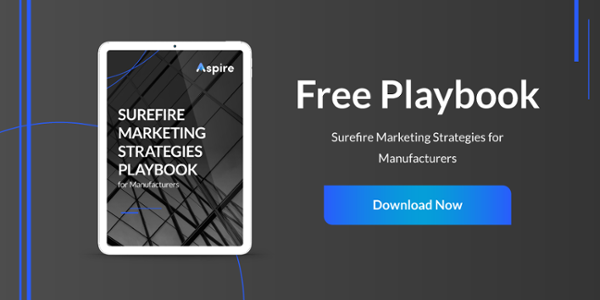- Manufacturing
- Revenue
- September 7, 2022
How Manufacturers Can Cut Sales Cycles in Half in Today's Market

Aaron Marks

Capitalize on How the Buying Process Has Changed for Manufacturers
B2B manufacturing has historically been among the slowest industries to adapt to technological change. This was true even with high-tech and startup manufacturing companies. Historically, the buying process typically involved lots of sales touches and business development. Trade shows, events, golf outings, nice dinners, and so forth were essential parts of selling.
That’s not to say these things have completely disappeared. But over the last decade, big changes have been afoot. As older industry buyers have retired and a new generation of buyers have come into leadership roles, the buyers’ expectations have changed. And many manufacturers have struggled to adapt.
This has been magnified since the pandemic, as buying cycles of high-tech and high-ticket manufactured products have grown longer. An extensive study found that more than 50% of B2B buyers have seen their purchasing timelines get longer over the last 12 months.
Coming out of the pandemic, longer buying timelines coupled with totally different buyer expectations have stifled the growth of many manufacturers.
That’s why a failure to respond to this reality can be disastrous. Let’s take a look at these trends in depth, including their implications and how top manufacturers are responding.
A Modern Buyer with Totally Different Expectations
For many manufacturers, in the past, marketing was a secondary priority to selling. This aligned with the buying process. Especially for higher ticket B2B products, buying decisions were often driven by a series of in-person interactions across events and trade shows, in-person meetups, on-site visits, complimentary meals, and more.
Over the last decade, that approach has been totally disrupted – and the changes continue to accelerate. There were two major drivers of these changes:
First, websites like Amazon became commonplace. These days, B2C consumers can do all their research online, without any interaction with a salesperson. And when they’re ready to buy, it’s a painless process on a website that invests billions of dollars each year in perfecting the user experience. And once that became the norm in B2C buying, B2B buyers quickly began to expect the same in their work lives.
This was accelerated by generational changes in the workplace. As more traditional buyers retired, a new generation of leaders and decision-makers emerged. These buyers had grown up using computers, buying on Amazon, and using a smartphone. They didn’t want to talk to a salesperson. They wanted to find and do business with vendors who make the entire buying process seamless and capable of being done online.
Indeed, it was almost a decade ago that Forrester forecasted in its “Death of a B2B Salesman” report that 1 million B2B salespeople would be displaced by digital shopping. That trend continues – and accelerates.
Manufacturers need to adapt by having an incredible buying experience filled with content for every stage of the funnel. A simple informational website with specs and data sheets is no longer enough. And this expectation is doubly true for manufacturers of high-ticket, high-tech products.
Major Changes in Buying Timelines in a Post-Pandemic World
Selling a B2B product, especially one that’s complex and relatively expensive, has always involved long buying timelines and lots of hands-on sales and marketing. But after the pandemic, these buying cycles became longer than ever.
In fact, a recent Demand Gen study found that 55% of respondents have seen their buying timelines increase over the last year. Only 6% said their timelines have gotten shorter!
This means that those 6-month buying cycles are now 9 months, and those 12-month buying cycles are now 18 months.
And despite our best wishes, there’s very little we can do to accelerate the process. Sadly, no amount of sales follow-ups or amazing marketing campaigns will make buyers come into the market more quickly.
This is the second half of why manufacturers need to create a robust library of informational and educational content. From blog posts to whitepapers to case studies, and everything in between, this content is essential to winning business despite longer sales cycles. Once that content is created, serving it up at the right place and at the right time in the buying process is also essential. For example:
- When a buyer visits your blog, it’s crucial to offer the “next step” piece of content for them to download in an obvious call-to-action.
- “Drip” nurture emails that get sent to a prospect over a period of weeks and even months ensure you stay top of mind while giving them the content they need to inform and enable their buying process.
- LinkedIn ads targeting your specific buyer, and even retargeting buyers who have visited your website before, allow you to deliver helpful content directly into your buyers' hands.
Still not persuaded? Well, just ask your buyers! That same Demand Gen study found that 63% of B2B buyers said their top criterion for evaluating a vendor was “easy access to relevant content that speaks directly to my company.”
Overcome Modern Challenges to Fuel Sustainable Growth
In this economic environment, the pressure to win new business is greater than ever. This is especially true for manufacturers who sell products that are complex, high-tech, and high-priced.
Today’s B2B buyers have totally different expectations for how they want to do business. These expectations are so strong that they will disqualify vendors who don’t meet them. Add on longer (and growing) buying cycles, and it’s easy to see why many manufacturers are struggling to keep up.
This is why helpful inbound marketing and content development is so essential to revenue growth. By building an amazing digital experience filled with content and resources that helps your audiences, you become memorable – and more importantly, you earn their trust.
With that double-punch of memorability and trust, you can ensure that your company stays top of mind and ultimately wins the business.
Aaron Marks is the Chief Marketing Officer of Execo. A digital pioneer with nearly two decades of online marketing experience, Aaron has helped organizations ranging from fledgling startups to Fortune 500 enterprises, and global manufacturers to U.S. Presidential campaigns, get the marketing and business results they needed.



0 Comments